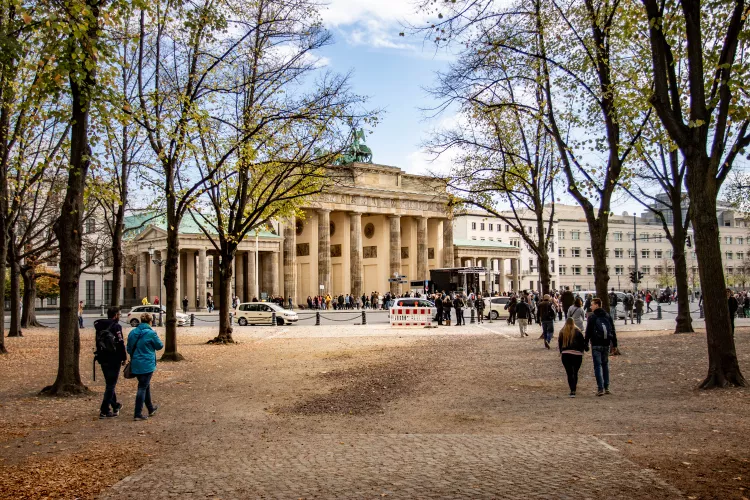Summary
The Brandenburg Gate (Brandenburger Tor) in Berlin is one of the first landmarks that come to mind when thinking of Germany. It is not only a symbol for the city, but also serves as a national icon, reflecting the country’s rich and tumultuous history.
German history was made here on numerous occasions, with the Brandenburg Gate playing various roles. Consequently, it mirrors the nation’s struggles and triumphs more distinctly than any other landmark in Germany.
Architecture of the Brandenburg Gate
Commissioned by Friedrich Wilhelm, the Brandenburg Gate was designed by architect Carl Gotthard Langhans in 1791. It replaced a former city gate marking the pathway from Berlin to the town of Brandenburg an der Havel.
The design is inspired by the Acropolis in Athens, forming the grand entrance to the famous boulevard Unter den Linden, which leads to the palatial residence of the Prussian monarchs, currently undergoing reconstruction.
Napoleon and the statue of Victoria
The Brandenburg Gate is crowned by the Quadriga, a sculpture featuring a four-horse chariot driven by Victoria, the winged goddess of victory. This sculpture has an interesting history; during the Napoleonic Wars in 1806, after the French defeated the Prussian army, Napoleon’s troops took the Quadriga to Paris. However, it returned to Berlin as a symbol of reclaiming pride when the Prussian army triumphed in 1814.
:max_bytes(150000):strip_icc():format(webp)/DSC_0001-5c66eb74c9e77c00011b1234.jpg)
Brandenburger Tor and the Nazis
Over a century later, the Nazis appropriated the Brandenburg Gate for their propaganda purposes. In 1933, they marched through the gate during a torchlight parade to celebrate Hitler’s ascendance, inaugurating a dark period in German history.
Although the Brandenburg Gate survived World War II, it was notably damaged. Restoration efforts saw the preservation of the sole remaining horse’s head from the Quadriga at Märkisches Museum.
Mr. Gorbachev, Tear Down This Wall!
During the Cold War, the Brandenburg Gate stood as a poignant symbol of the division between East and West Berlin. It became an inevitable part of the Berlin Wall. When John F. Kennedy visited in 1963, the Soviets hung large red banners to obscure the East from view.
In a memorable address at the gate, Ronald Reagan urged:
“General Secretary Gorbachev, if you seek peace, if you seek prosperity for the Soviet Union and Eastern Europe, if you seek liberalization: Come here to this gate! Mr. Gorbachev, open this gate! Mr. Gorbachev, tear down this wall!”
The peaceful revolution of 1989 ended the Cold War, culminating in the dramatic fall of the Berlin Wall. This pivotal moment saw thousands of Berliners from both sides converge at the Brandenburg Gate for the first time in decades, as David Hasselhoff performed live, marking a momentous occasion celebrated worldwide.
Brandenburg Gate Today
Post-reunification, the Brandenburg Gate stands as a symbol of a new Germany. Between 2000 and 2002, it underwent significant restoration by the Stiftung Denkmalschutz Berlin (Berlin Monument Conservation Foundation), continuing to serve as a source of inspiration for visitors. Tourists can enjoy sights such as a grand Christmas tree during the holiday season, celebrations marking Silvester (New Year’s concert), and year-round activities.
Visitor’s Information for the Brandenburg Gate
The Brandenburg Gate is a must-visit landmark, among the most frequented attractions in both Germany and Europe. Make sure to include this iconic site in your travel itinerary to Berlin.
Address: Pariser Platz 1, 10117 Berlin
Getting There: Unter den Linden S1 & S2, Brandenburg Gate U55 or Bus 100
Cost: Free
Other Historical Berlin Must-Dos
- The Brandenburg Gate is included in many historical tours of Berlin.
- Visit the iconic Fernsehturm (TV Tower) for a breathtaking view of the city.
- Explore the East Side Gallery – the longest remaining section of the Berlin Wall.
- Look for Stolpersteine memorials at your feet during your journey.




